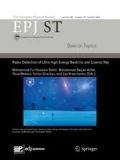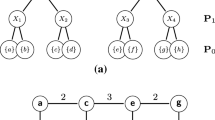Abstract
This tutorial review paper consolidates the existing applications of the power watershed (PW) optimization framework in the context of image processing. In the literature, it is known that PW framework when applied to some well-known graph-based image segmentation and filtering algorithms such as random walker, isoperimetric partitioning, ratio-cut clustering, multi-cut and shortest path filters yield faster yet consistent solutions. In this paper, the intuition behind the working of PW framework, i.e. exploitation of contrast invariance on image data is explained. The intuitions are illustrated with toy images and experiments on simulated astronomical images. This article is primarily aimed at researchers working on image segmentation and filtering problems in application areas such as astronomy where images typically have huge number of pixels. Classic graph-based cost minimization methods provide good results on images with small number of pixels but do not scale well for images with large number of pixels. The ideas from the article can be adapted to a large class of graph-based cost minimization methods to obtain scalable segmentation and filtering algorithms.

























Similar content being viewed by others
References
C. Allène, J.-Y. Audibert, M. Couprie, J. Cousty, Renaud Keriven et al., Some links between min-cuts, optimal spanning forests and watersheds. ISMM 1, 253–264 (2007)
Alpert, S., M. Galun, R. Basri, A. Brandt, Image segmentation by probabilistic bottom-up aggregation and cue integration. In: Proceedings of the IEEE Conference on computer vision and pattern recognition (2007). https://ieeexplore.ieee.org/abstract/document/4270042
P. Arbelaez, M. Maire, C. Fowlkes, J. Malik, Contour detection and hierarchical image segmentation. IEEE Trans. Pattern Anal. Mach. Intell. 33(5), 898–916 (2011)
P. Arbeláez, J. Pont-Tuset, J.T. Barron, F. Marques, J. Malik, Multiscale combinatorial grouping. In: Proceedings of the IEEE Conference on computer vision and pattern recognition, pp.328–335 (2014). https://doi.org/10.1109/CVPR.2014.49
I. Arganda-Carreras, S.C. Turaga, D.R. Berger, D. Cireşan, A. Giusti, L.M. Gambardella, J. Schmidhuber, D. Laptev, S. Dwivedi, J.M. Buhmann et al., Crowdsourcing the creation of image segmentation algorithms for connectomics. Front. Neuroanat. 9, 142 (2015)
L. Bao, Y. Song, Q. Yang, H. Yuan, G. Wang, Tree filtering: Efficient structure-preserving smoothing with a minimum spanning tree. IEEE TIP 23(2), 555–569 (2014)
Y. Boykov, O. Veksler, Graph cuts in vision and graphics: theories and applications. in Handbook of Mathematical Models in Computer Vision, ed. by N. Paragios, Y. Chen, O. Faugeras (Springer, Boston, 2006). https://doi.org/10.1007/0-387-28831-7_5
W. Casaca, A. Paiva, E. Gomez-Nieto, P. Joia, L.G. Nonato, Spectral image segmentation using image decomposition and inner product-based metric. J. Math. Imaging Vis. 45(3), 227–238 (2013)
L. Cerrone, A. Zeilmann, F.A .Hamprecht. End-to-end learned random walker for seeded image segmentation. In: Proceedings of the IEEE Conference on computer vision and pattern recognition, pp. 12559–12568 (2019). https://doi.org/10.1109/CVPR.2019.01284
A. Challa, S. Danda, B.S. Daya Sagar, L. Najman, An introduction to Gamma-convergence for spectral clustering. In: Discrete Geometry for Computer Imagery—20th IAPR International Conference, DGCI 2017, Vienna, Austria, September 19–21, 2017, Proceedings, vol. 10502, pp. 185–196 (2017)
A. Challa, S. Danda, B.S. Daya Sagar, L. Najman, Power spectral clustering on hyperspectral data. In: 2017 IEEE International Geoscience and Remote Sensing Symposium, IGARSS 2017, Fort Worth, TX, USA, July 23–28, 2017, pp. 2195–2198 (2017). https://doi.org/10.1109/IGARSS.2017.8127423
A. Challa, S. Danda, B.S.D. Sagar, L. Najman, Power spectral clustering. J. Math. Imaging Vis. 62(9), 1195–1213 (2020)
K.C. Ciesielski, A.X. Falcão, P.A.V. Miranda, Path-value functions for which Dijkstra’s algorithm returns optimal mapping. J. Math. Imaging Vis. 60(7), 1025–1036 (2018)
M. Cordts, M. Omran, S. Ramos, T. Rehfeld, M. Enzweiler, R. Benenson, U. Franke, S. Roth, B. Schiele, The cityscapes dataset for semantic urban scene understanding. In: Proceedings of the IEEE Conference on computer vision and pattern recognition, pp. 3213–3223 (2016). https://doi.org/10.1109/CVPR.2016.350
T.H. Cormen, C.E. Leiserson, R.L. Rivest, C. Stein, Introduction to Algorithms (MIT Press, Cambridge, 2009)
C. Couprie, X. Bresson, L. Najman, H. Talbot, L. Grady, Surface reconstruction using power watershed. In: International Symposium on mathematical morphology and its applications to signal and image processing, vol. 6671 (Springer, 2011), pp. 381–392
C. Couprie, L. Grady, L. Najman, H. Talbot, Anisotropic diffusion using power watersheds. In: 2010 IEEE International Conference on image processing, pp. 4153–4156. IEEE, (2010). https://doi.org/10.1109/ICIP.2010.5653896
C. Couprie, L. Grady, L. Najman, H. Talbot, Power watershed: a unifying graph-based optimization framework. IEEE Trans. Pattern Anal. Mach. Intell. 33(7), 1384–1399 (2011)
J. Cousty, G. Bertrand, L. Najman, M. Couprie, Watershed cuts: minimum spanning forests and the drop of water principle. IEEE Trans. Pattern Anal. Mach. Intell. 31(8), 1362–1374 (2009)
CREMI. Miccai challenge on circuit reconstruction from electron microscopy images. (2017). https://cremi.org/
S. Danda, A. Challa, B.S. Daya Sagar, L. Najman, Power tree filter: a theoretical framework linking shortest path filters and minimum spanning tree filters. In: Mathematical Morphology and Its Applications to Signal and Image Processing—13th International Symposium, ISMM 2017, Fontainebleau, France, May 15–17, 2017, Proceedings, vol. 10225, pp. 199–210 (2017)
S. Danda, A. Challa, B.S.D. Sagar, L. Najman, Revisiting the isoperimetric graph partitioning problem. IEEE Access 7, 50636–50649 (2019)
S. Danda, A. Challa, B.S.D. Sagar, L. Najman, Some theoretical links between shortest path filters and minimum spanning tree filters. J. Math Imaging Vis. 61(6), 745–762 (2019)
A.X. Falcao, J. Stolfi, R. de Alencar Lotufo, The image foresting transform: theory, algorithms, and applications. IEEE PAMI 26(1), 19 (2004)
R.W. Floyd, Algorithm 97: shortest path. Commun. ACM 5(6), 345 (1962)
L. Grady, Fast, quality, segmentation of large volumes—isoperimetric distance trees. In: Computer vision—ECCV 2006, 9th European Conference on Computer Vision, Graz, Austria, May 7–13, 2006, Proceedings, Part III, vol. 3953, pp. 449–462 (2006)
L. Grady, Random walks for image segmentation. IEEE PAMI 28(11), 1768–1783 (2006)
L. Grady, E.L. Schwartz, Isoperimetric graph partitioning for image segmentation. IEEE Trans. Pattern Anal. Mach. Intell. 28(3), 469–475 (2006)
L. Grady, E.L. Schwartz, Isoperimetric partitioning: a new algorithm for graph partitioning. SIAM J. Sci. Comput. 27(6), 1844–1866 (2006)
J. Grazzini, P. Soille, Edge-preserving smoothing using a similarity measure in adaptive geodesic neighbourhoods. Pattern Recognit. 42(10), 2306–2316 (2009)
C. Haigh, N. Chamba, A. Venhola, R. Peletier, L. Doorenbos, M. Watkins, M.H.F. Wilkinson, Optimising and comparing source extraction tools using objective segmentation quality criteria. arXiv preprint arXiv:2009.07586, (2020)
T. Hastie, R. Tibshirani, J. Friedman, The Elements of Statistical Learning: Data Mining, Inference, and Prediction (Springer, New York, 2009)
http://scikit-learn.org/stable/modules/generated/sklearn.datasets.make blobs.html.scikit-learndatasets. Accessed 12 Dec 2017
C. Jaquet, E. Andó, G. Viggiani, H. Talbot, Estimation of separating planes between touching 3d objects using power watershed. In: International Symposium on mathematical morphology and its applications to signal and image processing, (Springer, 2013), pp. 452–463
R. Lerallut, É. Decencière, F. Meyer, Image filtering using morphological amoebas. Image Vis. Comput. 25(4), 395–404 (2007)
B. Mohar, Isoperimetric numbers of graphs. J. Comb. Theory Ser. B 47(3), 274–291 (1989)
J.-M. Morel, S. Solimini, Variational Methods in Image Segmentation: With Seven Image Processing Experiments, vol. 14 (Birkhäuser, Basel, 2012)
J.M. Musser, K.J. Schippers, M. Nickel, G. Mizzon, A.B. Kohn, C. Pape, J.U. Hammel, F. Wolf, C. Liang, A. Hernández-Plaza et al., Profiling cellular diversity in sponges informs animal cell type and nervous system evolution. BioRxiv, p. 758276, (2019)
L. Najman, Extending the PowerWatershed framework thanks to \(\Gamma \)-convergence. SIAM J. Imag. Sci. 10(4), 2275–2292 (2017)
T.X. Nguyen, G. Chierchia, L. Najman, A. Venhola, C. Haigh, R. Peletier, M.H.F .Wilkinson, H. Talbot, B. Perret, Cgo: multiband astronomical source detection with component-graphs. In: 2020 IEEE International Conference on image processing (ICIP). https://doi.org/10.1109/ICIP40778.2020.9191276
J. Pont-Tuset, P. Arbelaez, J.T. Barron, F. Marques, J. Malik, Multiscale combinatorial grouping for image segmentation and object proposal generation. IEEE Trans. Pattern Anal. Mach. Intell. 39(1), 128–140 (2016)
J. Pont-Tuset, F. Marqués, Supervised evaluation of image segmentation and object proposal techniques. IEEE Trans. Pattern Anal. Mach. Intell. 38(7), 1465–1478 (2016)
A.S.G. Robotham, L.J.M. Davies, S.P. Driver, S. Koushan, D.S. Taranu, S. Casura, J. Liske, Profound: source extraction and application to modern survey data. Mon. Not. R. Astron. Soc. 476(3), 3137–3159 (2018)
C. Rother, V. Kolmogorov, A. Blake, “grabcut’’ interactive foreground extraction using iterated graph cuts. ACM Trans. Graph. (TOG) 23(3), 309–314 (2004)
J. Serra, Mathematical Morphology, vol. i (Academic, London, 1982)
J. Serra et al., Mathematical morphology for Boolean lattices. in Image Analysis and Mathematical Morphology, II: Theoretical Advances, (London Academic Press, 1988), pp. 37–58
J.L. Sérsic, Observatorio Astronomico (Cordoba, Argentina, 1968)
J. Shi, J. Malik. Normalized cuts and image segmentation. In: Proceedings of IEEE Computer Society Conference on computer vision and pattern recognition, pp. 731–737. IEEE, (1997)
R. Szeliski, Computer Vision: Algorithms and Applications (Springer, London, 2010)
C. Tomasi, R. Manduchi, Bilateral filtering for gray and color images. In: Sixth International Conference on computer vision, 1998. ICCV 1998, pp. 839–846. IEEE, (1998)
V.V. Vazirani, Approximation Algorithms (Springer, Berlin, 2001)
A. Venhola. Evolution of dwarf galaxies in the fornax cluster. PhD Thesis, http://hdl.handle.net/11370/1bcc02c2-2c78-4cff-b801-147c31b000a8, (2019)
U. Von Luxburg, A tutorial on spectral clustering. Stat. Comput. 17(4), 395–416 (2007)
S. Wolf, A. Bailoni, C. Pape, N. Rahaman, A. Kreshuk, U. Köthe, F.A. Hamprecht, The mutex watershed and its objective: Efficient, parameter-free graph partitioning. IEEE Trans. Pattern Anal. Mach. Intell. (2020). https://doi.org/10.1109/TPAMI.2020.2980827
S. Wolf, Y. Li, C. Pape, A. Bailoni, A. Kreshuk, F.A. Hamprecht, The semantic mutex watershed for efficient bottom-up semantic instance segmentation. In: European Conference on computer vision, vol. 12351 (Springer, 2020), pp. 208–224
S. Wolf, C. Pape, A. Bailoni, N. Rahaman, A. Kreshuk, U. Köthe, F.A. Hamprecht, The mutex watershed: Efficient, parameter-free image partitioning. in eds. V. Ferrari, M. Hebert, C. Sminchisescu, and Y. Weiss, Computer Vision—ECCV 2018 - 15th European Conference, Munich, Germany, September 8–14, 2018, Proceedings, Part IV, volume 11208 of Lecture Notes in Computer Science, (Springer, 2018), pp. 571–587
X. Lijuan, F. Wang, L. Dempere-Marco, Q. Wang, Y. Yang, H. Xiaopeng, Path-based analysis for structure-preserving ima ge filtering. J. Math. Imaging Vis. 62(2), 253–271 (2020)
Q. Yang, Stereo matching using tree filtering. IEEE PAMI 37(4), 834–846 (2015)
Acknowledgements
Sravan Danda would like to acknowledge the funding received from BPGC/RIG/2020-21/11-2020/01 (Research Initiation Grant provided by BITS-Pilani K K Birla Goa Campus) and thank APPCAIR, and Computer Science and Information Systems, BITS-Pilani Goa. Aditya Challa would like to thank Indian Institute of Science (IISc) for the Raman Post Doctoral fellowship. The work of B. S. D. Sagar was supported by the DST-ITPAR-Phase-IV project under the Grant number INT/Italy/ITPAR-IV/Telecommunication/2018. Laurent Najman would like to acknowledge the funding received from - ANR-15-CE40-0006 CoMeDiC, ANR- 14-CE27-0001 GRAPHSIP research grants and Programme d’Investisse- ments d’Avenir (LabEx BEZOUT ANR-10-LABX- 58). He would also like to thank the European Union’s Horizon 2020 research and innovation program under the Marie Skłodowska-Curie grant agreement No. 721463 to the SUNDIAL ITN network.
Author information
Authors and Affiliations
Corresponding author
Rights and permissions
About this article
Cite this article
Danda, S., Challa, A., Sagar, B.S.D. et al. A tutorial on applications of power watershed optimization to image processing. Eur. Phys. J. Spec. Top. 230, 2337–2361 (2021). https://doi.org/10.1140/epjs/s11734-021-00264-0
Received:
Accepted:
Published:
Issue Date:
DOI: https://doi.org/10.1140/epjs/s11734-021-00264-0




